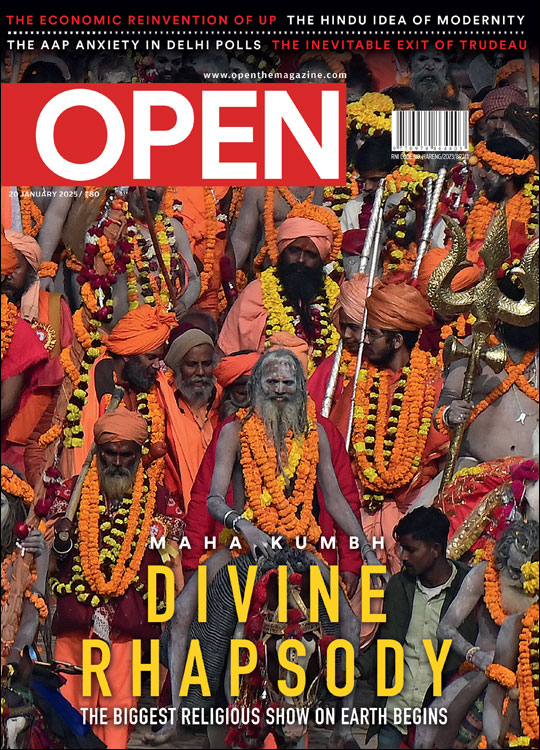Warren Hastings ‘Loved India a Little More Than His Own Country’
On the 70th anniversary of India’s independence, let’s redeem Warren Hastings from the worst trial of history
 Zareer Masani
Zareer Masani
 Zareer Masani
Zareer Masani
 |
06 Apr, 2017
|
06 Apr, 2017
/wp-content/uploads/2017/04/English1.jpg)
AS WE CELEBRATE 70 years of independence, is it time to acknowledge that it was the first British Governor- General who launched our cultural renaissance way back in the 1780s? Of all Britain’s imperial proconsuls, Warren Hastings was the most curious and learned about Indian culture and famously declared: “I love India a little more than my own country.” He was fluent in Bengali, had good working knowledge of Urdu and Persian, and pioneered the revival of Sanskrit, rescuing it from the narrow confines of a corrupt Brahmin priesthood.
It was Hastings who rediscovered India’s classical Hindu and Buddhist past, after seven centuries of mostly benign neglect under Muslim rulers. He founded the Calcutta Asiatic Society in 1784, under the distinguished Orientalist Sir William Jones, and it became the centre of a cultural revival which flowered in the Bengal Renaissance and laid the basis of India’s future cultural narrative. Hastings encouraged an ambitious programme to translate Hindu religious classics, himself writing a glowing introduction to the first-ever English translation of the Bhagavad Gita.
Warren Hastings was the most popular of all British Governor- Generals among his Indian subjects. So why was he alone put on trial for crimes against humanity in a seven-year-long impeachment in British Parliament, led by the great Whig orator Edmund Burke? The answer lies in the clash between two very different visions of empire: one respectful of Indian traditions and crudely labelled ‘Orientalist’, the other inspired by a Whig brand of Westernising liberal intervention. The Hastings trial would be the first of many battles between Orientalists and Anglicists.
Given his strong Indian sympathies, it’s ironical that the charges against Hastings focused on his alleged persecution of Indian subjects and allies. Edmund Burke, in his four-day-long opening speech, accused Hastings of having “gorged his ravenous maw…feeding on the indigent, the dying and ruined” like “the ravenous vulture… devouring the carcasses of the dead”. “I impeach him in the name of the English nation, whose ancient honour he has sullied,” Burke thundered, “I impeach him in the name of the people of India, whose rights he has trodden under foot, and whose country he has turned into a desert.”
Burke’s invective was far more vitriolic than any attacks on the British Raj by present-day Indian critics. But the subject of all this abuse was far from being the cruel monster we might suppose. Unlike his aristocratic successors as Governor- General, Hastings had to work his way up from modest beginnings. He began in 1750, aged 17, as a clerk for the East India Company, sent to an up-country factory at Kasimbazar in Bengal, where he ‘depended for society mainly on the natives of the country’, mixing with them on an equal footing unusual for British administrators.
Hastings’s excellent Indian connections helped him emerge unscathed from the battles of the 1750s between the Company and the Nawab of Bengal, Siraj ud-Daula. Appointed as Resident at the court of a new, British-sponsored Nawab, Mir Jafar, Hastings supported the latter’s fragile authority against European inroads, complaining that the Nawab was being exposed ‘to daily affronts such as a spirit superior to that of a worm when trodden on could not have brooked’.
Promoted to the Governor of Bengal’s Council in 1761, Hastings continued to support the Nawab’s attempts to curb the illegal, private trading privileges that corrupt Company employees were claiming to evade local taxes. Matters came to a head when an energetic new Nawab, Mir Kasim, decided it was time for the worm to turn. He abolished all internal customs duties in Bengal and established free trade, thereby denying British traders their unfair advantages. The Company, despite Hastings’ opposition, retaliated by declaring war on the Nawab. Hastings was accused of being the latter’s ‘hired solicitor’ and hit in the face by an angry fellow Council member. The decisive British victory at the Battle of Buxar in October 1764 marked the end of any autonomy for future Nawabs.
Hastings, ‘disheartened and disillusioned’, resigned his post and returned to England, ‘being unwilling…to give authority to past measures of which I disapprove’. There his Indian career might have ended unnoticed, had he not been compelled by near- bankruptcy to seek re-employment by the Company four years later. He returned to India in 1769 to a minor post in Madras. Two years later, he was unexpectedly appointed Governor of Bengal, a post later elevated to that of Governor-General, with authority over the two subordinate Presidencies of Madras and Bombay.
Hastings was warmly received by King George III, although Whig wits ridiculed him for showering the royal family with ‘fine diamonds’ and ‘a certain richly carved ivory bed which the Queen had done him the honour to accept from him
Writing to his still very influential predecessor, Lord Clive, Hastings bravely made it clear that he intended to tackle his dubious legacy ‘in a different line from that which a different situation of affairs required Your Lordship to pursue’. This was necessitated, he wrote, by ‘the general licentiousness which seems to have prevailed since we took the internal administration… out of the hands of the former [Nawab’s] Government and placed them without any fixed system in those of our agents’. Hastings intended to revive the old Mughal administration and to avoid measures ‘which the original constitution of the Mogul Empire hath not before established and adopted and thereby rendered familiar to the people’.
He was keen to confine European institutions and personnel to the bounds of Calcutta and to leave the actual collection of revenues and administration of justice to Indian intermediaries. He believed that European administrators were more prone to abuses of power. ‘There is a fierceness,’ he warned, ‘in the European manners, especially among the lower sort, which is incompatible with the gentle temper of the Bengalee…’, whereas ‘native oppression was less truculent, more easily punished, more familiar to the people and in every way preferable to the corrupt tyranny of overbearing Englishmen’.
And yet it was that very tyranny of which Hastings stood accused at the end of his Indian career. Heading the list of his alleged victims were the Rohillas, Afghan settlers on the borders of the kingdom of Avadh (now Uttar Pradesh). Struggling with demands to remit larger revenues back to London, Hastings had rented out Company troops to the Nawab of Avadh in return for a handsome subsidy. The charge of war crimes arose when he allowed the Nawab to use these mercenaries to invade and annex the Rohilla lands.
According to Hastings’ later accusers, he looked callously on while Rohilla ‘villages were burnt, their children butchered, and their women violated’. In reality, the Rohilla War was no more violent than any other Indian conflict of its time, and Hastings was quick to warn the Nawab of Avadh against any excesses. The charge of war crimes against the Rohillas was based on fictitious reports fed back to the British press by Hastings’ formidable nemesis, the Whig politician, Sir Philip Francis. He was one of a new batch of Council members sent out to Calcutta, took an instant dislike to Hastings and spent the next decade opposing his every move. The enmity between the two eventually escalated into a duel with pistols, from which Francis emerged wounded but unrepentant.
A more fatal casualty of this battle was a banker called Nandakumar, a powerful ally of the Francis faction, who alleged that Hastings had been taking bribes. Although his accusations could not be substantiated, this wily Brahmin became a centre for opposition to Hastings, who complained: ‘Nandakumar holds his darbar in complete state, sends for zamindars and their wakils, coaxing and threatening them for complaints, which no doubt he will get in abundance, besides what he forges himself.’
Edmund Burke’s invective was far more vitriolic than any attacks on the British Raj by Indian critics of the day. But the subject of all this abuse was far from being the cruel monster we might suppose
Thanks to his popularity among both the Indian notables of Calcutta and the Company’s officials, Hastings was able to turn the tables. Based on evidence from Indian informants, Nandakumar was charged with forgery in Calcutta’s new Supreme Court, presided over by Hastings’ old school friend, Sir Elijah Impey. Though a minor offence in India, forgery then carried the death penalty under British law. Nandakumar was found guilty by a European jury, sentenced to death and hanged. His execution marked a major turning point in Hastings’ political fortunes in Calcutta, deterring any other Indians from collaborating with his opponents. Today the judicial murder of his chief Indian opponent remains a major blot on Hastings’ reputation and a glaring departure from his own much proclaimed view that Indians should be governed by Indian, not European, laws.
HASTINGS MANAGED TO inflict decisive military defeats on an anti-British coalition between the French and two major regional powers, the Marathas and the Muslim warlord Haidar Ali of Mysore. Though essential to the Company’s survival, these wars imposed considerable financial strains and accounted for two major crimes of extortion, of which Hastings later stood accused. The first was his treatment of the enormously wealthy and respected Raja Chait Singh of Benares.
Hastings decided that, as a vassal of the Company, the Raja was fair game for the extraction of funds badly needed for the war effort. But Chait Singh paid reluctantly ‘after much procrastination and many unreal pleas of poverty’. More seriously, he was believed to be in correspondence with the Company’s Maratha enemies; and to cap it all, he was cosying up to the hostile Francis faction on Hastings’ own Council.
In 1780, the Governor-General resolved to teach the Raja a lesson and sailed up the Ganges to deal with him in person. Chait Singh, we are told, ‘met him in a very contrite mood…, laid his turban at his feet in token of his complete submission, begged forgiveness and assured him that all his property was at his disposal’. But when Hastings insisted on a written apology, the Raja politely refused.
What followed was a serious error of judgement by the irate Governor-General. Hastings sent his sepoys to arrest Chait Singh, whereupon the Raja’s far more numerous retainers mounted an armed rescue of him. It was the Governor-General who now found himself under virtual siege from the rebels, until reinforcements arrived to rescue him.
The rebellion was suppressed, but Hastings failed to extract the financial or military aid which had been the purpose of the whole exercise. His biographer, Sir Penderel Moon, himself a veteran of the Indian Civil Service, concluded that Hastings’ treatment of the Raja, ‘judged even by despotic standards was both severe and unwise; and, judged by his own high standards of courtesy and consideration towards Indian notables, it was deplorable’.
Though essential to the Company’s survival, these wars imposed financial strains and accounted for two major crimes of extortion, of which Hastings later stood accused
Another episode soon after won Hastings even more opprobrium back home, because it involved the intimidation of two venerable old princesses allied to the Company, the Begums of Avadh, mother and grandmother of its Nawab. The kingdom of Avadh, bordering Bengal to the north and west, was both a valuable buffer against the Marathas and a rich source of subsidies paid for the hire of Company troops. But its extravagant young ruler, Asaf ud-Daula, had been running up huge debts, and his kingdom was descending into chaos. Hastings was determined to restore Avadh to the status of a solvent and stable neighbour. It was a formidable challenge because the Nawab, though a great patron of the arts, was renowned for the debauchery of his court, reputed to include a male harem.
Asaf’s biggest debts were to the Company, and Hastings badly needed these funds to finance the wars in the south. He decided that the quickest way of getting them was by persuading Asaf to recover some of his father’s huge wealth, which had been appropriated by the late Nawab’s widow and mother. Egged on by Hastings, the Nawab, with the British Resident and Company troops to support him, laid siege to his wealthy mother and grandmother in their fortress- palace of Faizabad. When the Begums refused to part with their inheritance, the Nawab arrested their two favourite eunuchs, who managed their household, put them in irons and starved them of food. The eunuchs then coughed up ‘from the most secret recesses of their houses’ the huge sum of 1 crore of rupees (about Rs 640 crore today).
At Hastings’ impeachment, his treatment of the Avadh dowagers provoked some of the most emotive outbursts from Edmund Burke and the most dramatic attacks from Richard Brinsley Sheridan, the Whig MP who was also the most popular playwright of his day. Their speeches were full of ‘love-passion’ for the wronged princesses, and even seasoned British MPs could not recollect weeping ‘so heartily and copiously on any public occasion’. Hastings was accused of personally instigating physical torture of the imprisoned eunuchs and of starving the Begums into submission. But Penderel Moon points out that the Begums themselves were later reconciled with Hastings, sent messages of support to him at his trial and bore him no ill will.
The great Whig historian and imperial policy-maker, Thomas Macaulay, though critical of Hastings, conceded that ‘he made himself beloved by both the subject many and by the dominant few’ and ‘enjoyed among the natives a popularity… such as no other governor has been able to attain’. During his own years in Calcutta half a century later, Macaulay could still hear ‘nurses sing children to sleep with a jingling ballad about the fleet horses and richly caparisoned elephants of Sahib Warren Hosein’.
When Hastings retired in 1785, he left British administration in India on a sounder footing than ever before. He expected his successes to be rewarded with the same favours as Clive had received, and at first all seemed to go well. Hastings was warmly received by King George III, although Whig wits ridiculed him for showering the royal family with ‘fine diamonds’ and ‘a certain richly carved ivory bed which the Queen had done him the honour to accept from him’. London gossip was particularly cruel about the extravagance of Hastings’ beautiful, German wife, who allegedly appeared at one function wearing jewels worth a staggering £2 million in today’s money.
In the public mind, Hastings had become symbolic of the East India Company, widely unpopular for its role in buying up British MPs and corrupting British politics. His old enemy, Philip Francis, now an active Whig backbencher in Parliament, had been feeding Edmund Burke with ammunition. When Burke threatened to bring a motion of censure against him, Hastings dared him to do his worst. The result was one of the last impeachments in British history, a procedure whereby the House of Commons acts as prosecutor in a case tried by the House of Lords. It was a measure reserved for what were considered ‘high crimes and misdemeanours’ beyond the remit of other courts, and it could carry the death penalty.
The trial, first in the House of Commons and then in the Lords, cost Hastings the modern equivalent of £8 million, almost his entire fortune. Whatever the truth of the corruption charges against him, his wealth was tiny compared with that of Clive and many other India-returned ‘Nabobs’. For seven long years, the Hastings impeachment in the grand Westminster Hall was the most popular show in town. Packed audiences included the royal family, and London’s fashionable society queued from dawn to buy tickets, which changed hands for as much as £50 each (£4,000 today).
Hastings, a poor public speaker, had to reckon with the oratory of Burke, Sheridan and other Whig leaders. Their performances excited the ladies present to ‘a state of uncontrollable emotion’, and ‘handkerchiefs were pulled out; smelling bottles were handed out; hysterical sobs and screams were heard: and Mrs Sheridan was carried out in a fit.’ Burke himself made the most impassioned speeches for several hours at a stretch, until he collapsed in a faint.
When the charges were eventually put to the vote in 1795, Hastings was acquitted, mainly because the evidence against him was inconclusive, and in some cases fabricated. But he received none of the honours he had expected and lived on in semi-retirement till the grand old age of 85. In 1813, both Houses of Parliament rose spontaneously to give him a standing ovation when he came to give evidence on new legislation about India.
In a letter which would be his last political testament, Hastings warned his successor, the Marquess of Hastings (no relation), that Indians had been misrepresented ‘as sunk in the grossest brutality and defiled with every abomination’, thereby justifying British attempts ‘to reform them, nay to ‘coerce’ them into goodness’. Instead, he exhorted his namesake, ‘it will be better to leave them as they are…’ He concluded with a plea for racial equality, remarkable for its time:
‘Among the natives of India, there are men of as strong intellect, as sound integrity and honourable feelings, as any of this Kingdom. I regret that they are not sufficiently noticed, sufficiently employed nor respected… Be it your Lordship’s care… and by your example make it the fashion among our countrymen to treat them with courtesy and as participators in the same equal rights of society.’
Hastings’s sympathetic, ‘Orientalist’ approach to India lost out to a Westernising sense of imperial mission, summed up by Burke’s dictum that ‘it was the duty of a British Governor to enforce British laws, to correct the opinions and practices of the people, not to conform his opinion to their practice’. Half a century later, British administrators led by Macaulay put this precept into practice with reforms designed to create a new class of ‘Brown Sahibs’. Warren Hastings would not have approved.
The Hastings impeachment was an act of imperial soul- searching unparalleled in history; and no one who wades through its voluminous archives can fail to be impressed. For seven years, British MPs and lords examined and debated in the most minute detail almost every document that had crossed the desk of their Indian Governor- General. Many were inspired by hostility to the East India Company, but there was also genuine concern for the human rights of Indians. Although Hastings was eventually acquitted, his trial laid down lasting ground rules for the conduct of future imperial governors, warning that even the most mighty could be called to account by parliament. That at least would have afforded Warren Hastings some consolation.

/wp-content/uploads/2025/01/Cover_Kumbh.jpg)













More Columns
The lament of a blue-suited social media platform Chindu Sreedharan
Pixxel launches India’s first private commercial satellite constellation V Shoba
What does the launch of a new political party with radical background mean for Punjab? Rahul Pandita